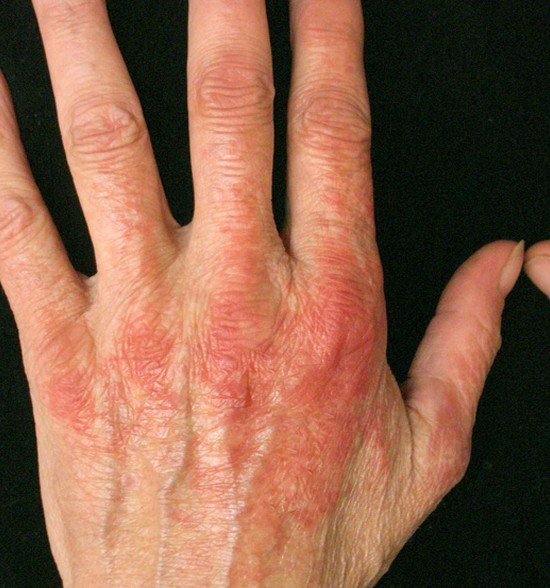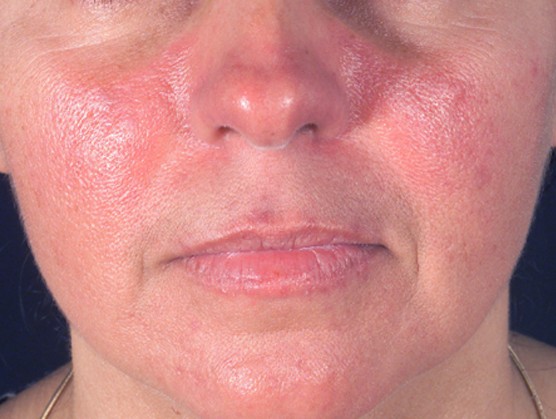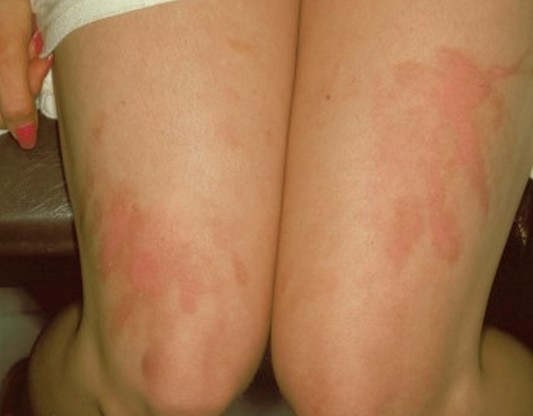Photodermatitis
Last reviewed by Dr. Raj MD on January 12th, 2022.
What is Photodermatitis?
This is a form of allergic contact dermatitis and is different from other forms of contact dermatitis. The difference is that with contact with the allergen that causes this form does not cause any symptoms until your skin is exposed to sunlight. The word dermatitis means inflammation of your skin.
Any part of your skin that has been exposed to sunlight may be affected but it depends on the allergen that triggers photodermatitis. Photodermatitis is also called sun poisoning. A person is more like to develop photodermatitis when the UV ray wavelength is at their highest.
Symptoms of Photodermatitis
Although the symptoms can vary from person to person the usual symptom that you have with photodermatitis is a red rash that is itchy. This type of rash may resemble small blisters that are fluid-filled. The surrounding area along with the blisters may peel. Some of the other symptoms that you might experience can include:
- The blotches of skin with the rash may itch for an extended period of time
- Hives
- Swelling
- Development of dark skin patches on your skin called hyperpigmentation
- Dry, scaly skin patches
- Burning sensation on your skin
- Lesions that looks similar to Eczema.
The skin of the area that is affected by photodermatitis may become scarred if this skin condition persists over a long period of time. If it is a severe case of photodermatitis you may also have flu-like symptoms like nausea, vomiting, fever, and fatigued.
Photodermatitis Pictures
Photodermatitis Picture 1 – on hands
Photodermatitis Photo – on Face
Photodermatitis – on legs (thighs)
Causes of Photodermatitis
It is a medical condition that is considered to be associated with an immune reaction that is abnormal. There can be many underlying causes or allergen triggers that can cause photodermatitis, which can include:
- Chemicals such as hexachlorophene and salicylanilide. Hexachlorophene is found in some antibacterial cleansers and soap and salicylanilide is an ingredient that can commonly be found in industrial cleansers.
- Medications like antibiotics, which cause a person to have increased sensitivity to the sunlight, along with pain relieving medication like ibuprofen. Other medications that could cause photodermatitis include anti-anxiety medications, antidepressants, and non-steroidal anti-inflammatory drugs, anti-malarial medications like quinine and chemotherapy agents.
- Plants that contain compounds that trigger this reaction like wild carrots, limes, lemons, figs, parsnips, celery, and parsley
- Skincare products that are photo-sensitizers, which include benzoyl peroxide, lemon oil, coal tars, retinoids, musk, and PABA. PABA is a common ingredient that is found in sunscreen and retinoids and benzoyl peroxide are ingredients found in wrinkle creams and acne treatment products.
- Coal tar is usually found in treatment products for psoriasis and eczema, and musk and lemon oil are ingredients in fragrances.
- Herbal remedies like St. John’s Wort
- Pellagra, which is a deficiency in vitamin B or niacin
- Autoimmune disorders such as lupus
- Inherited tendency to photosensitivity
Risk factors
Although photodermatitis can happen to anyone regardless of age, gender, or race it is seen more in people who have blond or red hair, fair or light-skinned, and have green and blue eyes.
If you spend longer than 30 minutes at a time in the sun with little to no protection and the period in which you are in the sun such as early morning or early afternoon when the UV ray levels are the highest.
Photodermatitis Treatment
If a reaction occurs with no warning, you can rinse the area that is affected with cold water to remove the allergen that has caused this skin condition and the cool water will also give you some relief. For the itchiness, you can use Calamine lotions or take an over-the-counter antihistamine like Benadryl.
Because most antihistamines cause drowsiness you should only take it at night or when you do not drive. Normally photodermatitis will resolve quickly on its own with just minimal treatment. If any medications are given they work by suppressing your immune system. One of the medications that are given to help control the symptoms is called glucocorticoids. Your physician may also prescribe hydroxychloroquine, which is an anti-inflammatory medication.
Your physician may also use phototherapy, which is based on a controlled exposure to light to help desensitize your skin along with helping to control the symptoms. Unfortunately it is not a treatment that is suitable for everyone. You may also be told to take nutritional supplements if you have a niacin or vitamin-B deficiency.
If you do not identify the allergen it can become a chronic skin condition.
Prevention
To help prevent photodermatitis you need to identify what is causing this skin condition and avoid using it in the future. You should also read the ingredients on your sunscreen products and use ones that are free of PABA. You should also try to limit the time you spend in the sun between the hours of 11 a.m. and 2 p.m. when the sun is its hottest. Avoid tanning beds and tanning lamps.


